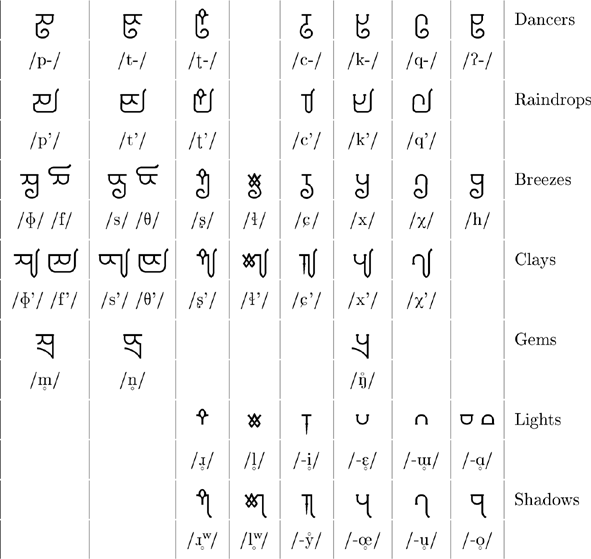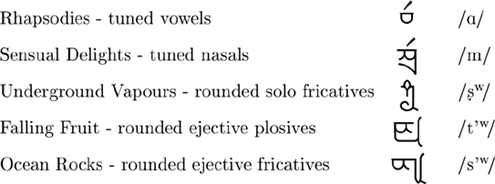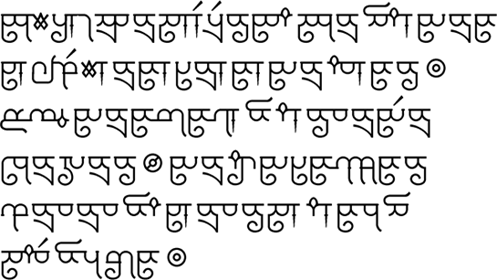h1>Xylphika
![]()
Xylphika was invented by Ian James in 2008. It was inspired by various ancient
South Asian writing systems, and is an offshoot of his major linguistic project
(soon to be published). The name Xylphika is a pseudo-Greek back-derivation from
Paracelsus’ coinage, meaning ‘out of the Sylphic’, suggesting translation from
the words of an imaginary, intelligent, elfin-like people.
Internal history
Xylphika is the rarely-seen written form of a language sometimes heard by humans,
who usually don’t realize it is a language at all, or who do, but can’t believe
their ears. It is used by an ancient race of human-like beings who, through the
use of various tricks, remain almost completely invisible to modern humans. They
are often confused with elves or undines.
Features of the language
- voicing is rarely applied, so most speech resembles whispering.
- phonemes are grouped systematically, and are named after elements of their
mythology. - the sounds are extremely soft, sweet and fascinating to human listeners.
- phrases are often delivered in swift outbursts; these are usually rich in meaning.
- phrases can also be delivered in long continuous streams by using both egressive
and ingressive phonemes; these are usually light-hearted or seductive in nature. - voiced plosives (/b/ /d/ /g/ etc) are considered vulgar, and only emerge in
very rare displays of anger or frustration. - the language has changed very little over the last 5,000 years and all dialects
across the planet are still mutually intelligible to a great extent. - many species of animal and bird can understand it well, but few can speak it.
- when written on water, information in the text can be stored in the body of
water, to be later retrieved directly by the tongue (details of this technique not known).
Features of the script
- phonetically consistent.
- vowels are considered extensions to consonants and their phonemic region
(or vice versa), so the script functions more like a syllabary than an alphabet. - voiced phonemes carry diacritics above, which give melodic information;
the simplest/vaguest mark is an acute. - other modifications to the base forms are written as tails below the baseline.
- ingressive phrases are written upside-down (reflected vertically).
- the basic letters are easy to write, but complex decorative filigree and
knotting is usually added, the style of which depends on region and tribe. - most phrases are composed so they can be read in reverse with little loss of
meaning; this is due to peculiarities of the grammar and the strong use of metaphor;
these then form semantic palindromes. - most artifacts of writing are intentionally disguised as natural formations, or
written at such great speed that the letter forms become very free and irregular,
or written with impermanent materials. - there are many more writing systems for Xylphika than there are dialects; the one
reproduced here is from a South Pacific region.
Xylphika script
The phoneme groups


One-sided forms of the E and W bases are also available for use in certain
combinations.
Other phonemes:

Egressive forms of all the above phonemes are called Governing. Many of them
can be ingressive; they are then called Astral.
Rare phonemes:
Dead trees – voiced fricatives
Human weapons – voiced plosives
Other symbols:
![]()
Sample text
The following passage is an imitation of human speech, mostly whispered:

Approximate transliteration:
All human beings are born free and equal in dignity and rights.
They are endowed with reason and conscience and should act towards
one another in a spirit of brotherhood.
(Article 1 of the Universal Declaration of Human Rights)
In high bardic Xylphika this passage would have read as a joke
about two human brothers married to the same wife.
